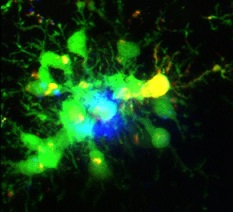Impairment of in vivo calcium signaling in amyloid plaque-associated microglia
 Neuroinflammation is a hallmark of Alzheimer’s disease (AD) both in man and in multiple mouse models, and epidemiological studies link the use of anti-inflammatory drugs with a reduced risk of developing the disease. AD-related neuroinflammation is largely mediated by microglia, the main immune cells of the central nervous system. In vitro, executive functions of microglia are regulated by intracellular Ca2+ signals, but little is known about microglial Ca2+ signaling in vivo. Here we analyze in vivo properties of these cells in two mouse models of AD. In both strains plaque-associated microglia had hypertrophic/amoeboid morphology and were strongly positive for markers of activation such as CD11b and CD68. Activated microglia failed to respond reliably to extracellular release of adenosine triphosphate (ATP, mimicking tissue damage) and showed an increased incidence of spontaneous intracellular Ca2+ transients. These Ca2+ transients required activation of ATP receptors and Ca2+ release from the intracellular Ca2+ stores, and were not induced by neuronal or astrocytic hyperactivity. Neuronal silencing, however, selectively increased the frequency of Ca2+ transients in plaque-associated microglia. Thus, our in vivo data reveal substantial dysfunction of plaque-associated microglia and identify a novel Ca2+ signal possibly triggering a Ca2+-dependent release of toxic species in the plaque vicinity.
Neuroinflammation is a hallmark of Alzheimer’s disease (AD) both in man and in multiple mouse models, and epidemiological studies link the use of anti-inflammatory drugs with a reduced risk of developing the disease. AD-related neuroinflammation is largely mediated by microglia, the main immune cells of the central nervous system. In vitro, executive functions of microglia are regulated by intracellular Ca2+ signals, but little is known about microglial Ca2+ signaling in vivo. Here we analyze in vivo properties of these cells in two mouse models of AD. In both strains plaque-associated microglia had hypertrophic/amoeboid morphology and were strongly positive for markers of activation such as CD11b and CD68. Activated microglia failed to respond reliably to extracellular release of adenosine triphosphate (ATP, mimicking tissue damage) and showed an increased incidence of spontaneous intracellular Ca2+ transients. These Ca2+ transients required activation of ATP receptors and Ca2+ release from the intracellular Ca2+ stores, and were not induced by neuronal or astrocytic hyperactivity. Neuronal silencing, however, selectively increased the frequency of Ca2+ transients in plaque-associated microglia. Thus, our in vivo data reveal substantial dysfunction of plaque-associated microglia and identify a novel Ca2+ signal possibly triggering a Ca2+-dependent release of toxic species in the plaque vicinity.
see more: http://link.springer.com/article/10.1007%2Fs00401-013-1242-2
- 72 views
